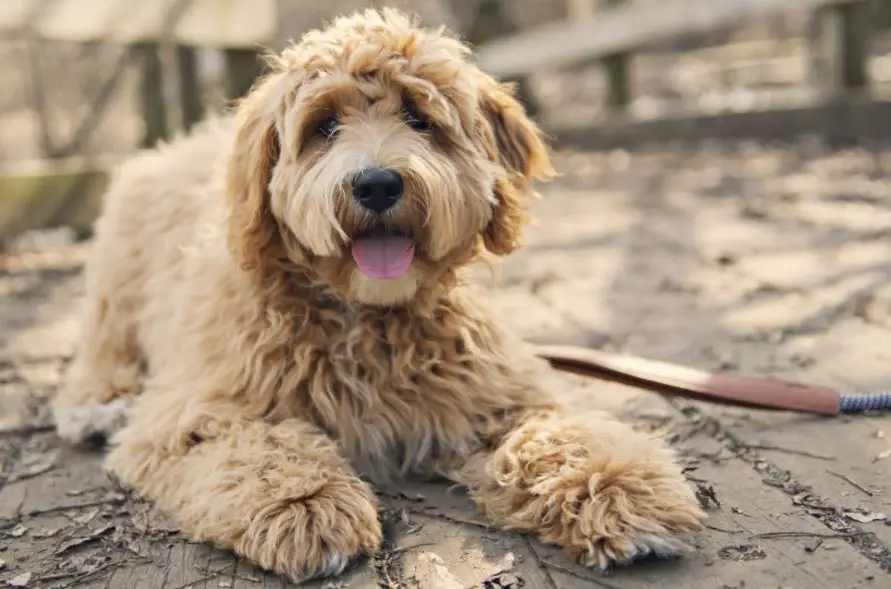Irish Doodles Pros and Cons – Everything You Need to Know About the Breed

If you’re looking for a family-friendly dog that’s intelligent and lively, then the Irish Doodle is a perfect choice.
Your Doodle won’t shed much and soon will become a loyal member of your family.
History
If you haven’t heard of an Irish Doodle before, you’re not alone. Unfortunately, the breed has only been in existence for about 30 years.
Also, they aren’t recognized as an actual breed by the American Kennel Club. But they are recognized by the International Designer Canine Registry as a breed.
Irish Doodles are also called Irish Poo setter, Setter Doodle, and Irish Setter Doodle.
These dogs are a crossbreed between Poodles and Irish Setters. The dogs are medium-sized and are light-hearted, cute, and friendly.
This particular hybrid was thought to originate in the United States.
However, because of the difficulty of telling the difference between a designer dog and a mutt, it’s impossible to know when the breed exactly came into the origin or where it came from.
Pros
- Life expectancy: The life expectancy of your dog will be 10-13 years if well-cared for. This is a long time for a dog of their size. However, many factors can reduce your dog’s life expectancy, such as poor living conditions, infrequent vet care, an inappropriate diet, or other unfavorable conditions.
- Temperament: Your pup is a family-friendly and smart designer dog. Both of your dog’s parents are athletic and love spending time with their owners. These dogs are good with children, can be your child’s closest friend and playmate.
They adapt well to family life and will display childlike enthusiasm while remaining patient when needed. But as a caution, monitor your children when they are playing with your dog or any other dog.
- Intelligent: Your Irish Doodle gets his intelligence from the Poodle side of his parentage. This makes it easy for your dog to understand and carry out commands. Since the Poodle is the second most intelligent dog breed, he should quickly pick up basic commands.
- Low shedding: Generally, an Irish Doodle is considered a low shedding breed. If your dog takes after its poodle parent, your dog may shed hardly at all. However, if your pup takes after its Irish Setter parent, you could have a dog that sheds moderately.
An Irish Doodle is not usually a heavy shedder. Still, if you allow your dog’s coat to become long, you will have a more serious shedding issue. This is because of the Irish Setter parent that tends to have long fur and shed moderately. But if you brush your dog once or twice a week, this can be avoided.
- Hypoallergic: As you know, there isn’t any dog that is genuinely hypoallergic. The Irish Doodle was created initially to work as a therapy or service dog for people who are allergic to dogs. These dogs are thought to be hypoallergenic because there is little to no shedding. So it’s the perfect dog for people that suffer from allergies.
- Sociable: These dogs are never afraid to meet new people. Your Doodle is sociable that likes to interact with strangers. He also won’t act overly protective of the family home or surroundings.
Your pup will adapt quickly to different surroundings and situations. Doodles enjoy being around people, so bringing your pup along with you on your daily exercise or jaunts won’t be a problem.

Cons
- Separation anxiety: If you fail to socialize your dog correctly, he can develop severe separation anxiety. Separation anxiety is something that occurs when a dog is left home alone. The symptoms can be destructive chewing and digging, howling, crying, excessive barking, and even defecating inside the house.
For example, if your dog is in his crate, he could drag reachable items into his crate, nonstop scratching inside his cage, or chew what he had drug into his cage into small pieces.
Irish Doodles can experience separation anxiety from the Irish Setter side. It’s because Irish Setter’s become very attached to their owners quickly. If you need to leave your Irish Doodle for more than three hours a day, then this dog may not be the right one for you.
- Price: An Irish Doodle is one of the rarest Doodle designer breeds. The price for them is not cheap when buying from a reputable breeder. The cost of your puppy will depend on where and how the puppies are bred. Plus, what colors are the puppies are with the rarer colors being more expensive. It also depends on how well they are cared for.
The price will also reflect the lineage papers, vetting, and accessories. So, your Irish Doodle puppy could cost between $1,500 to $5,000 or even more. True, a lower-quality breeder will charge less, but you may make up the cost of health problems.
When looking to adopt your Irish Doodle puppy, you need to visit the facilities where the puppy is located. Examine all the paperwork and documents that come with your puppy before you fall in love and make a commitment.
- Training: If your new puppy takes after his Irish Setter parent, he may be challenging to train. Irish setters become bored quickly or distracted during training. It may take 15-25 times of repetition to learn a new command. As a result, they may obey the first command only 70% of the time.
The Poodle, on the other hand, learns quickly and retains it. So, if your Irish Doodle inherits traits from his Irish Setter parent, you could be in for a challenge.
- Grooming: With grooming, your Doodle could range from moderate to high maintenance. It depends on his coat. He could have either a wavy or a curly coat, with the curly coat shedding the least amount.
So, because your pup doesn’t shed, a curly coat will get matted or tangled easily if it isn’t brushed regularly. Or your puppy could have a wavy coat that can grow longer. It’s up to you to decide how long your dog’s coat should be.
If it’s left long, then it will need to be brushed daily. If it’s kept short, then you’ll only have to brush your dog 2-3 times a week. You need to check for mats and knots in the groin and paw pits. If these form, it can cause your dog pain when he moves.
You need to check your dog’s ears as well when grooming. The ears should be cleaned as often as needed. Plus, brushing your dog’s teeth several times a week will keep plaque from developing.
- Exercise requirements: The Irish Doodles were also bred as hunting dogs, so your dog will do well with tracking and agility. However, your dog will need to have a lot of daily exercise because he is so highly energetic. Your Doodle will also get bored easily if he’s left indoors too long without something to do.
But your pup can adjust to your schedule when getting a moderate amount of exercise. Of course, you will need to make time to play with your pup outdoors or indoors. You can also buy interactive toys which will burn off some of that excess energy.
Appearance

The two most common sizes of Irish Doodles are standard and miniature. They make standard Doodles weigh about 50 to 70 pounds and standing between 24 to 28 inches tall. The females are about 40 to 60 pounds and stand about 22 to 26 inches tall.
The Mini–Irish Doodles are the tiny version of the original Irish Doodles. Half of their DNA comes from a miniature poodle, not the Standard Poodle. The Mini’s stand at 12 to 17 inches tall and weigh about 25 to 35 pounds on average. They resemble the Golden Doodle, but they have dark apricot coats and the slim build of the Irish settler mother.
Most Irish Doodles will have a single coat thick like a poodle but wavy without the tight curls. The coats are generally dense, with long wavy curls. But it can differ from dog to dog depending on which parent the Doodle takes after.
The color variations of the coats of these dogs can be golden light red to deeper mahogany, black, or apricot. Some can have white socks or chests. There are other colors that can show up depending on the generation. These colors are a little rarer and are brown, cream, blue, and silver. There can be partial colors, too, with combinations of white and red.
These dogs are elegant in movement and athletic in build. The breed’s ears usually hang as low as their beard or even slightly below. They have dark brown eyes, which even makes them look more like teddy bears.
Health Problems
Like all mixed breeds, a puppy can inherit health issues from both or either side of their parents.
This is usually a healthy breed, but there are some potential problems that you should be aware of before bringing your pup home. Some of the conditions are:
- Bloat: Bloat occurs when your dog’s stomach becomes filled with fluid, gas, or food and then puts pressure on other organs. If this happens, it can make it extremely difficult for your dog to breathe. If you think your pup has bloat, you need to get him to the vet as soon as possible. It’s because this condition can worsen quickly. If you feed your dog a diet of small portions frequently, then bloat can be prevented.
- Hip Dysplasia: When your dog’s hip ball and socket don’t fit together or don’t properly develop, then hip dysplasia can develop. What happens then is your pup’s hips grind together then slide when he moves. This condition can cause a complete loss of joint function or deterioration.
- Eye Disorders: Both of these breeds have a history of eye disorders and problems. Progressive retinal atrophy is the most common eye condition of dogs. It can lead to blindness, but a reputable breeder will have the purebred parents tested for this type of health problem.
- Von Willebrand’s Disease: This genetic bleeding disorder is caused by the deficiency of the von Willebrand Factor. For blood clotting or platelet binding, the sticky glycol-protein is needed. If this condition is not treated, the disease can cause severe injury because of non-clotting blood.
Other Facts

A Standard Irish Doodle will reach its maximum height at around 12 months of age. After that, your dog will continue to gain weight until he reaches about 18 months. If your pup is one of the miniature sizes, he will reach his adult height in the first two months with being completely grown by their first birthday.
If your puppy takes after his Irish Setter parent, he may not mature until about the age of four. The puppy antics may be exhibited for a while, so be patient.
The Irish Doodle is the perfect dog for single owners, couples, and active families. They are energetic, intelligent, happy-go-lucky, and sociable.
This is not an easy breed to find since they aren’t as common as the other Doodle breeds. However, you can also check your local humane society or rescue to see if they have any available. In addition, several statewide organizations may be able to help you find one.
The breed is not known for barking excessively. Instead, they usually bark to tell you that someone is around or if something isn’t right. Plus, if you call your dog, he may not always listen, especially when hunting a squirrel or other backyard visitors.
Until your puppy’s growth plates are fully developed, avoid excessive running, treks, or excessive hiking. Irish Doodles are at a higher risk of developing skeletal disorders if not carefully watched in their younger years.
Conclusion:
Suppose you would like a family-oriented, intelligent, low-shedding dog who is good with people and loves his owner. In that case, the Irish Doodle is the perfect dog for you.
If you would like more information about the Irish Doodle, please click the link below:
https://www.youtube.com/watch?v=19spYLs083w
References:
https://allpetslife.com/irish-doodle/


